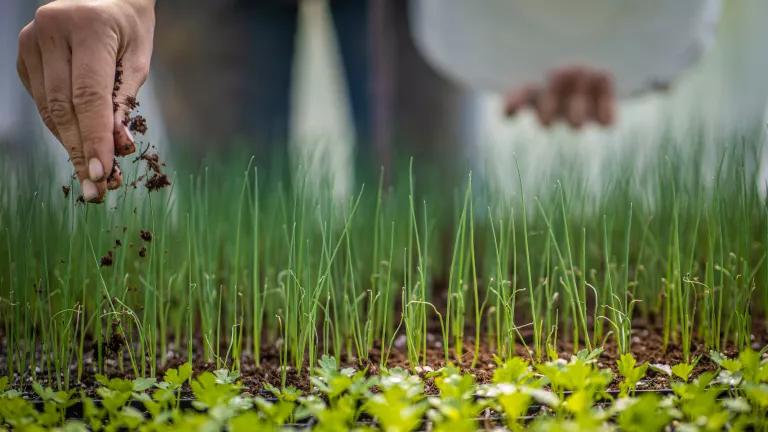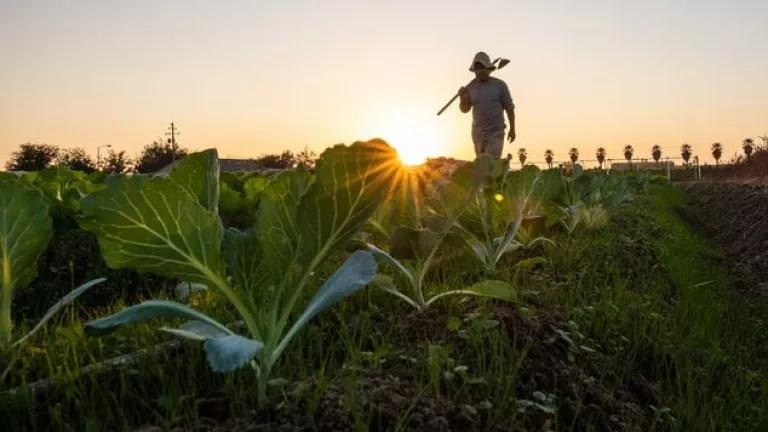Dirt to Soil: Proving the Power of Regenerative Agriculture

In his new book Dirt to Soil, Gabe Brown, an NRDC Growing Green award winner and prominent soil health advocate in the United States, shares how he transitioned his farm away from the conventional monocropping ubiquitous in North Dakota to one that looks at agriculture holistically. After having his yields repeatedly destroyed by hail and drought, Gabe decided to work with nature instead of against her. This is what regenerative agriculture asks of farmers: to think of their farms, especially their soil, as biodiverse, microbe-rich ecosystems.
Gabe’s principles for soil health are born from decades of experimentation and prove, time and time again, the resilience of his farm to natural disasters, drought, and commodity price spikes/drops:
- Instead of killing weeds (and other healthy microbes) with herbicides, Gabe’s cover crops naturally suppress weeds.
- Instead of killing insects with pesticides, Gabe changes his crop rotations so frequently that “pests on [his] ranch have no clue what is coming next and thus cannot gain a foothold."
- Instead of breaking the bank on fertilizers and synthetic inputs, Gabe diversifies his cover crops and crop rotations to naturally feed the microbes in his soil and to keep them active.
- Instead of pumping excessively from groundwater wells during drought, Gabe does not till and keep roots in the soil to help increase natural water infiltration so that when it rains, water stays on his farm.
Dirt to Soil made me think about how the benefits of investing in soil health accrue beyond our farms.
- Investing in soil health is investing in public health—cover crops and crop rotations reduce the need for pesticides, protecting and preserving air and water quality.
- Investing in soil health is investing in financial health—no till, cover crops, and crop diversity reduce the money spent on water, fertilizers, and pesticides and saves the federal government money on crop insurance payouts. As a California native, the potential for regenerative agriculture to reduce surface water deliveries and reduce nitrate runoff into drinking water supplies resonates deeply.
- Investing in soil health is investing in environmental health—Gabe’s soil health principles help our farmers transition away from current extractive farming to a system that works with what nature already has to offer.
Gabe does not sugar coat how difficult it is to move away from the status quo, conventional monocropping farming prevalent in North Dakota. Even though Gabe was constantly told by friends, magazines, universities, extension services, and crop advisors that he had to fertilize more and produce more to feed the world, he proves that trusting “plant and soil intelligence” and using the nutrients available in different crops can save him money, plan for the long-term, rebuild ecosystems, and transform his dirt into rich, active, highly-productive soil.
We need to support farmers like Gabe. His resilience and determination got him to where he is now, but it is not easy. The federal government and state governments are missing an opportunity to make the economy, our communities, and our environment more resilient. We need make it easier for farmers to transition into regenerative agriculture. For starters we can:
- Reform crop insurance to make it easier for farmers to adopt and experiment with regenerative agriculture practices. Federal crop insurance heavily subsidizes monocropping and squeezes profits out of farmers so that their small margins don’t allow for the kind of experimentation that Gabe shares throughout his book. Our farmers are America’s first small business entrepreneurs, and when the federal government subsidizes one type of agricultural system over others, it's hard for other farming systems to compete.
- Encourage widespread use of a comprehensive soil test, like the Haney Soil Test, so that farmers see the existing nutrient and microbial potential of their soil without needing to add unnecessary synthetic inputs.
- Reward farmers for investing in soil health stewardship practices that make their farms more resilient. California FarmLink’s Resource Efficiency Loan Program, for example, pays back farmers who improve the use of water and reduce nutrient runoff.
Whether you’re an environmental advocate like me or a consumer eager to learn more about regenerative agriculture, Dirt to Soil has a story to offer everyone. Gabe’s compelling testimonial shows us that we all have a role in advocating for an agricultural system that works for all of us.



